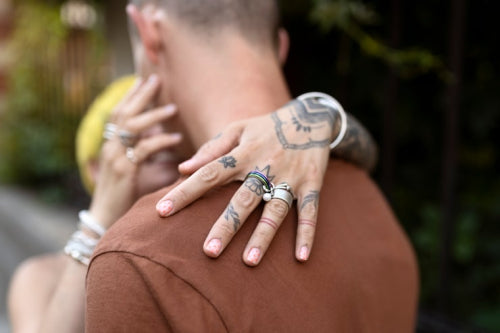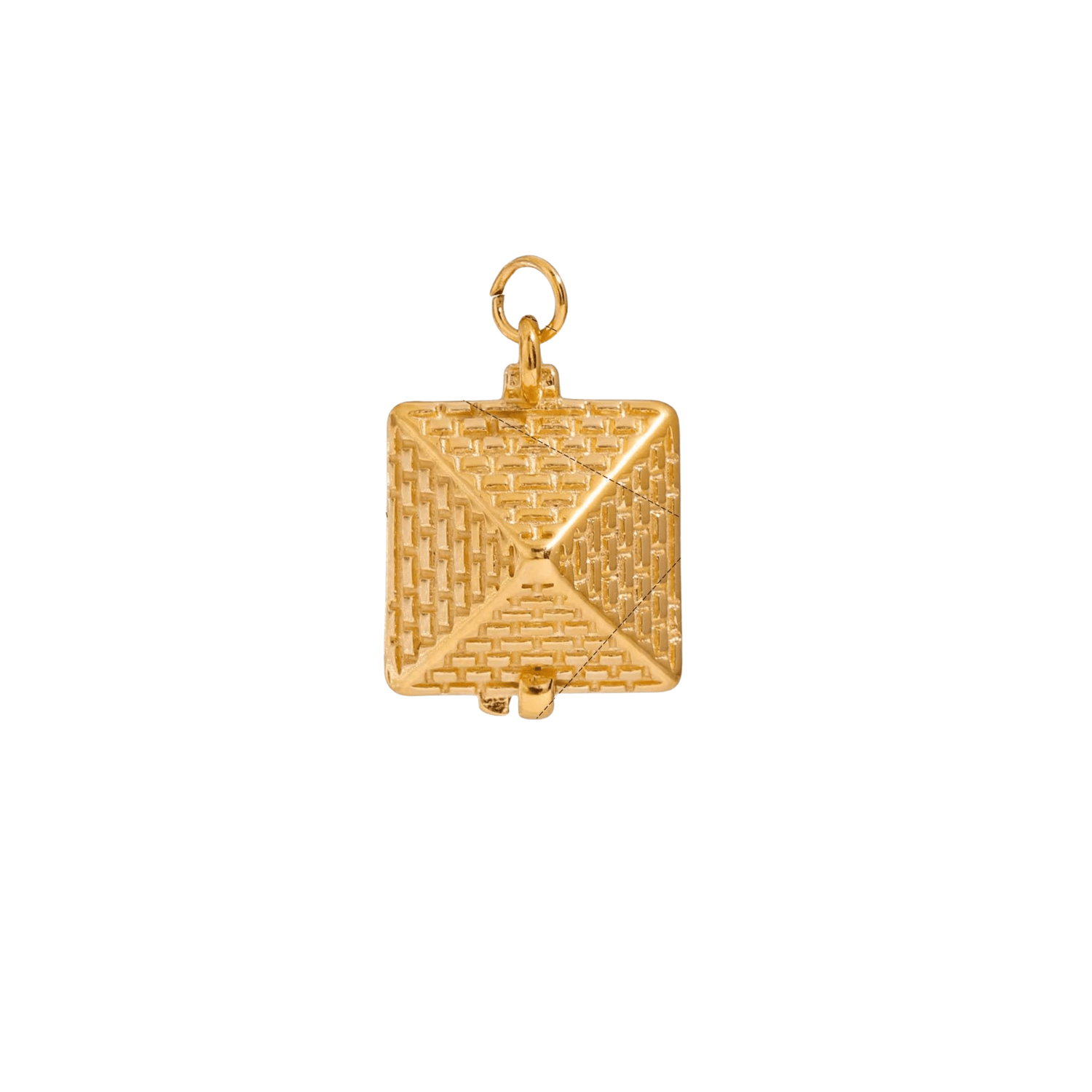
The Shift Towards Gender-Neutral Jewelry Designs
Share
In the vibrant heart of Mumbai's Zaveri Bazaar, where the air shimmers with the glow of gold and the calls of vendors echo through crowded alleys, jewelry has always transcended mere decoration it's a profound cultural emblem. For generations, Indian jewelry has been steeped in tradition, typically segmented by gender: intricate bangles adorning women's wrists, robust chains signifying men's status. Yet, in dynamic urban landscapes such as Mumbai, Delhi, and Bengaluru, a subtle yet significant transformation is underway. Empowered by growing disposable incomes and a desire for authentic self-expression, younger consumers are rejecting these entrenched norms, opting instead for jewelry that transcends gender boundaries. This evolution represents more than a fleeting fashion wave; it's a pivotal cultural shift drawing attention from designers, retailers, and savvy investors.
Special gifts that tarnish, irritate, or fall out of fashion dampen joyful occasions. That disappointment clouds memories meant to endure. Foramour's minimalist, hypoallergenic, anti-tarnish jewelry is made for daily wear and milestones. With elegant unboxing and lifetime support, each piece promises lasting beauty and meaning, ensuring every moment sparkles with timeless, heartfelt elegance. Shop Now!
Ushering in an Inclusive Aesthetic
The global jewelry market stood at an estimated USD 366.79 billion in 2024, with projections indicating a climb to USD 578.45 billion by 2033, fueled by a compound annual growth rate of 5.3% between 2025 and 2033. This expansion is largely propelled by escalating disposable incomes, shifting fashion dynamics, and a heightened appetite for opulent, customized adornments. In India, where jewelry serves as both a badge of prestige and a cherished heirloom, this upward trajectory is especially evident. Metropolitan areas including Delhi-NCR, Mumbai, and Hyderabad are experiencing a marked increase in interest for gender-neutral creations envision understated rings, streamlined chains, and artistic earrings that resonate universally, irrespective of gender. Leading this movement are Gen Z and millennial demographics, who emphasize inclusivity and personal uniqueness, compelling brands to overhaul their conventional portfolios.
Consider the transformation in high-end boutiques within Gurugram's luxurious shopping centers or Mumbai's trendy Bandra neighborhood. Previously focused on distinct "his and hers" assortments, numerous outlets are now pivoting to "for all" branding, presenting items that erase gender distinctions. A basic gold ring, formerly targeted solely at female clientele, now graces fingers across the spectrum, its minimalist contours attracting a diverse clientele. This change mirrors a wider societal progression toward embracing diversity, bolstered by social media initiatives and influencers who advocate for jewelry as an avenue for individual narratives rather than prescribed gender roles.
Innovators Reshaping Tradition
Indian jewelry enterprises are embracing this movement with enthusiasm. Direct-to-consumer ventures, flourishing via channels like Instagram and Myntra, are introducing unisex ranges that fuse time-honored elements such as gold and silver with modern flair. During prestigious gatherings like Lakmé Fashion Week, creators unveil gender-fluid items imagine substantial silver bracelets or subtle diamond earpieces that captivate a youthful, city-dwelling audience. These innovations frequently borrow from international influences, akin to the unique, asymmetrical shapes championed by figures like Loveness Lee. As detailed in a Vogue Business feature, Lee, a London designer who started her brand in 2017 out of dissatisfaction with mainstream options, draws from her abstract painting roots to mold detailed structures from natural sources like cactus frameworks and barnacle casings, crafting sculptural accessories. This inherent variability ensures each piece is uniquely personal and unrepeatable, a quality that echoes in Indian artisans exploring unconventional, abstract motifs.
A notable illustration comes from a Delhi-centric label that unveiled a collection of tarnished silver necklaces, promoted not through gender lenses but by aesthetic moods audacious, subtle, or whimsical. Distributed via JioMart and temporary boutique setups, these offerings have appealed to individuals in their twenties and thirties across genders, demonstrating that aesthetics surpass antiquated conventions. Partnerships with apparel designers further magnify this direction, as catwalk presentations display diverse models donning identical prominent pendants or ear ornaments, serving as a potent symbol that inclusivity extends beyond mere rhetoric.
Navigating Obstacles in a Heritage-Rich Landscape
Nevertheless, amid the vibrancy in major cities, the advocacy for gender-neutral jewelry encounters obstacles. In India's secondary and tertiary urban tiers, where customary principles prevail, shoppers frequently adhere to gender-specific anticipations ornate bangles for matrimonial women, substantial chains for male counterparts. Merchants observe pushback from mature patrons who perceive jewelry as an indicator of societal positions rather than a medium for personal artistry. Affordability poses another critical challenge. The Indian jewelry sector remains highly responsive to pricing, requiring brands to navigate the delicate balance between upscale, diverse designs and cost-effectiveness to engage both cosmopolitan innovators and prudent regional consumers.
Additionally, the peril of superficial inclusivity looms large. Certain labels hastily apply "inclusive" designations to lines without fundamentally altering their creative philosophy, potentially estranging discerning buyers adept at detecting pretense. Major retail chains have also lagged in integrating gender-neutral options, relegating the initiative to specialty shops and digital pioneers. Notwithstanding these impediments, the drive persists, notably in locales like Pune and Hyderabad, where emerging consumers are recasting jewelry as a stylistic declaration unbound by gender legacies.
Capturing Emerging Prospects
The commercial rationale for gender-neutral jewelry proves persuasive. Transitioning from compartmentalized "men's" and "women's" categories enables firms to optimize stock management and trim promotional expenditures, a significant advantage in a cutthroat arena. The worldwide jewelry domain, dominated by the Asia Pacific region holding a 60.2% portion in 2024, highlights the area's clout, with India playing a central role. Gold, securing a 54.9% segment of the international market, continues as a core material, yet creators are merging it with streamlined, unisex styles to entice junior patrons. Rings, commanding a 33.8% market allocation, stand out for their adaptability across gender lines.
Advancements in retail are likewise propelling advancement. Virtual reality fitting applications, increasingly prevalent on sites like Myntra, empower customers to envision a refined necklace or striking armlet on themselves, independent of gender. Online-centric promotions, frequently spearheaded by influencers in Delhi and Bengaluru, are standardizing these aesthetics, with trending labels such as #JewelryForAll amassing followers. For merchants, the prospect resides in harnessing India's expanding adolescent demographic those in their twenties and thirties who regard jewelry as a prolongation of their persona, not a societal dictate.
Envisioning a Boundary-Free Horizon
As the Indian jewelry sphere progresses, the inclination toward gender-neutral aesthetics appears less transitory and more as a foundational realignment. Creators and industry associations anticipate that diversity will characterize the forthcoming ten years of commerce, with urban-originated patterns progressively infiltrating secondary markets. Authorities emphasize that genuineness is paramount fashioning items that connect intimately, beyond promotional tactics. Enterprises committing to daring, region-specific drives and enveloping retail encounters, such as augmented reality-enhanced digital outlets, are positioned to dominate.
In a nation where jewelry has enduringly symbolized lineage, the adoption of gender-neutral motifs heralds a wider receptivity to transformation. From the refined displays in Gurugram's emporiums to the lively energy of Bengaluru's style milieu, Indian patrons are reauthoring the guidelines. Echoing a designer's sentiment, "It's no longer confined to men's or women's adornments it's about what evokes your true self." Within this fundamental insight resides the destiny of a sector poised to radiate inclusively for all.
Frequently Asked Questions
What is driving the trend toward gender-neutral jewelry in India?
The shift toward gender-neutral jewelry in India is primarily driven by Gen Z and millennial consumers in metropolitan areas like Mumbai, Delhi, and Bengaluru who prioritize inclusivity and authentic self-expression over traditional gender norms. Rising disposable incomes and the influence of social media campaigns advocating for jewelry as personal storytelling rather than prescribed gender roles are also key factors fueling this cultural transformation.
How are Indian jewelry brands adapting to create unisex designs?
Indian jewelry brands are embracing gender-neutral designs by launching "for all" collections that feature minimalist gold rings, streamlined chains, and artistic earrings that appeal universally. Direct-to-consumer brands are particularly active on platforms like Instagram and Myntra, creating unisex ranges that blend traditional elements like gold and silver with modern aesthetics. Many brands are also marketing their pieces based on aesthetic moods bold, subtle, or whimsical rather than targeting specific genders.
What challenges do gender-neutral jewelry brands face in the Indian market?
Gender-neutral jewelry brands in India face several key challenges, including resistance from traditional consumers in secondary and tertiary cities who still prefer gender-specific designs, and pushback from older customers who view jewelry as status symbols rather than personal artistic expression. Additionally, brands must balance creating upscale, inclusive designs while maintaining affordability in India's price-sensitive jewelry market, and avoid the trap of superficial inclusivity that discerning consumers can easily detect.
Disclaimer: The above helpful resources content contains personal opinions and experiences. The information provided is for general knowledge and does not constitute professional advice.
You may also be interested in: Hypoallergenic Gold Products Bridge Medical and Fashion Worlds
Special gifts that tarnish, irritate, or fall out of fashion dampen joyful occasions. That disappointment clouds memories meant to endure. Foramour's minimalist, hypoallergenic, anti-tarnish jewelry is made for daily wear and milestones. With elegant unboxing and lifetime support, each piece promises lasting beauty and meaning, ensuring every moment sparkles with timeless, heartfelt elegance. Shop Now!
Powered by flareAI.co

